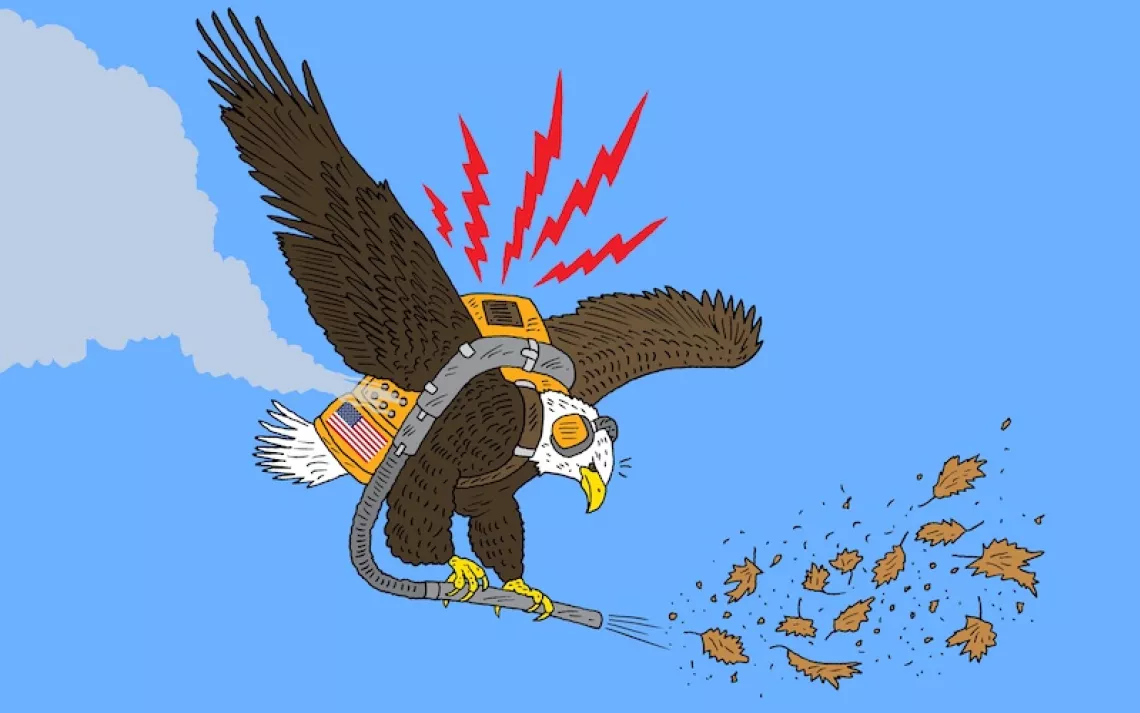Suck It Up
Everyone's in favor of carbon dioxide removal—including the fossil fuel industry, which sees it as a lifeline


SINCE THE DARK, satanic mills of the Industrial Revolution began spewing coal smoke into the air, humanity has added more than a trillion metric tons of carbon dioxide into Earth's atmosphere, changing its elemental composition. Half of that enormous load has been emitted since the mid-1980s. Now, the weather's going haywire, the forests are burning, and that beachfront house is looking like a really bad investment.
It's not as if no one saw this coming. I wrote about the science of the greenhouse effect in these pages 25 years ago. In 1988, James Hansen, a former director of NASA's Goddard Institute for Space Studies, told Congress that global warming was already happening. That same year, the United Nations established the Intergovernmental Panel on Climate Change. Since then, successive international conferences—Kyoto, Copenhagen, Paris, Glasgow—have led to sweeping pledges and further conferences and further reports. The most recent IPCC report came out in spring, and it had all the subtlety of a blow to the head with a two-by-four. The world "on a fast track to climate disaster," warned UN Secretary-General António Guterres. "Delay means death."
Despite more than three decades of ever more dire reports from the world's most eminent climate scientists, delay remains the order of the day. Renewables have moved from dream technologies to the world's cheapest forms of energy, yet the Keeling Curve—the famous graph that since 1958 has charted the concentration of carbon dioxide in Earth's atmosphere—has continued its steady rise, unperturbed by exhortations from the United Nations or the righteous anger of children marching in the streets. When Hansen delivered his stark warning to Congress, atmospheric CO2 stood at 352 parts per million, already past the 350 ppm threshold that he had established as the maximum safe level. Today, the atmospheric CO2 is at 420 ppm.
In 2015, the 192 nations at the Paris climate conference pledged to do what it takes to keep the global average temperature from rising more than 1.5°C (2.7°F)—or surely keep it to "well below" 2°C. How to accomplish that goal wasn't a mystery: The IPCC had been telling us for decades that if we want a livable planet, we need to stop burning fossil fuels and replace them with clean energy sources as quickly as possible.
We haven't done that—at least, not yet, and not at the scale that's required. Had we listened to Hansen in 1988, we could have limited global warming by simply pivoting to clean energy. The world could have decarbonized by 2 percent a year and met the Paris goal. Even in 2015, a rapid transition to clean energy might have done the trick. But after decades of manufactured climate denial, governmental foot-dragging, and desperate delaying tactics by the fossil fuel corporations, we now need to decarbonize three times as fast, by 6 to 7 percent a year. Carbon emissions need to peak by 2025 at the very latest, and investments in clean energy need to increase three- to sixfold.

The hour is so late that even breakneck decarbonization isn't enough. That's why the latest IPCC report added a new requirement to humanity's survival to-do list: proactively remove excess carbon from the atmosphere.
"All available studies require at least some kind of carbon dioxide removal to reach net zero," the IPCC said. "[T]here are no studies where absolute zero GHG or even CO2 emissions are reached by deep emissions reductions alone." For every 0.1°C degree of cooling we need to save our bacon, the IPCC authors say, we need to remove 220 billion tons of CO2 from the atmosphere by the end of this century. In the IPCC's most optimistic scenario for staying below 1.5°C, the world will need to remove 5 billion tons of carbon a year by 2050 and 17 billion a year by 2100.
That enormous task is necessary because we have so badly overshot our carbon budget: that is, the amount of carbon we can emit before we blow through the Paris goals. The current global carbon budget stands at about 306 billion tons. Today, global industrial society emits nearly 1,300 tons of CO2 every second. US carbon emissions—from all the power plants, factories, cars and trucks, home and building heating, and more—are about 5 billion tons a year. The Mercator Research Institute on Global Commons and Climate Change tracks how long it will be until we overshoot the global carbon budget. As of this writing, we've got seven years, two months, 26 days, two hours, and 27 minutes.
IN THE ACRONYM ARGOT of policy experts, taking carbon from the atmosphere and putting it someplace else is called CDR—carbon dioxide removal. It can be accomplished via natural processes, via advanced technologies, or by a hybrid of the two. Environmentalists tend to favor the natural options. Trees, for example, sequester vast amounts of carbon. A hardwood tree might store a ton of carbon by the time it is 40 years old, so protecting existing forests and peatlands and reforesting logged-over, burned, or otherwise degraded lands holds a lot of promise (see "The Giving Trees"). Carbon is also naturally sequestered in healthy soils, a process that smart farming practices and regenerative agriculture can encourage (see "Dirt First").
There are also several high-tech options for carbon dioxide removal. The current fan favorite (with adherents ranging from Elon Musk and Bill Gates to many environmentalists) is direct air capture (DAC). As its name suggests, direct air capture extracts CO2 from ambient air via a process usually involving large fans and chemical sorbents. Once captured, the carbon can be buried underground or put to other uses. Two firms are already marketing diamonds made from air-captured carbon, promising "all of the bling, none of the sting."
Somewhat related is carbon capture and storage (CCS), a technology dating from the 1920s that involves passing flue gases through a solution of amines (a derivative of ammonia) that absorbs the CO2. When the solution is reheated, it releases the gas, at which point the CO2 can be stored away forever in some deep, dark cavern. Or, as is more often the case, the CO2 is injected into a depleted oil well to force out the leftover petroleum in a process known as "enhanced oil recovery." CCS is best suited to large industrial facilities and could (theoretically) be used to zero out emissions from difficult-to-decarbonize industries like steel, cement, and chemical production.
(Note that CCS isn't technically a "drawdown" technology, as it doesn't remove carbon from the atmosphere. Rather, it prevents carbon from getting into the air in the first place when fossil fuels are being burned. Even if it works perfectly, it's a carbon wash. Spoiler: It doesn't work perfectly.)
The hybrid, natural-techno drawdown option is bioenergy with carbon capture and storage (BECCS). The idea is to plant fast-growing woody species like switchgrass or poplar trees that suck carbon dioxide out of the atmosphere old-school style, via photosynthesis and respiration. This biomass would then be burned or otherwise processed to make electricity or liquid or gaseous fuel.
If the process stopped at that point, there would be no net carbon reduction. Upon combustion (or fermentation, in the case of ethanol), the biomass's carbon would just return to the atmosphere, making the whole process carbon neutral at best. But if that CO2 were to be captured via afforestation or technological CCS and stored away, then—voilà—we have an energy system that would be carbon negative. Maybe.
As the years passed and the nations dawdled on ditching fossil fuels, the IPCC's models became more dependent on carbon dioxide removal to make the carbon-budget math pencil out. In the panel's 2018 assessment, scientists were still hedging on CDR, saying that while it would very likely be needed, "the effectiveness of such techniques are unproven at large scale, and some may carry significant risks for sustainable development." Fast-forward to 2022, and the body now concludes that CDR "is a necessary element to achieve net zero." All of its pathways to climate stabilization factor in natural carbon sequestration and/or BECCS.
Environmentalists are broadly in favor of the concept of carbon drawdown, if often skeptical about the details. The Sierra Club's formal policy describes atmospheric removal of carbon dioxide as "compulsory," acknowledges that "emissions reductions alone are inadequate to meet the 1.5°C target," and, unsurprisingly, favors prioritizing natural methods. Like many others, Bruce Nilles, the executive director of the Climate Imperative Foundation and a former head of the Sierra Club's Beyond Coal campaign, would be happy if technological drawdown methods were shown to be feasible. "If we are doing everything we possibly can to eliminate carbon dioxide," he says, "and at the same time working to bring levels down to a safer level, [direct air capture] sounds like an option we should keep in our back pocket."
Carbon drawdown is an alluring but fraught notion. We need it to work, but that doesn't mean that it will. Militating against it are technical hurdles (will it work?), biophysical limits (is there enough space on Earth for it?), and financial obstacles (who's gonna pay for it all?). Not to mention practical political difficulties (how do you get Mitch McConnell on board?).
Then there is CDR's "moral hazard," the danger that the prospect of a get-out-of-jail-free card will lessen the urgency to accomplish the most important task, which is to stop burning fossil fuels. The hazard is not theoretical. The publication of the latest IPCC report was delayed by six hours because Saudi Arabia insisted on the inclusion of language that suggests carbon capture and storage can delay the elimination of oil and gas. "Depending on its availability," read the final report, "CCS could allow fossil fuels to be used longer, reducing stranded assets." Case in point: Earlier this year, a New Mexico utility planned to close a coal-burning plant and replace it with renewables, but a group of investors wants to keep it going until they make enough money to install carbon-capture equipment—a period they refer to as "pre-decarbonization."
These factors combine to make carbon drawdown a minefield for environmentalists, policymakers, and anyone concerned with preserving the planet. The longer governments and corporations delay in making the "rapid and deep and in most cases immediate greenhouse gas emissions reductions" the IPCC says we need, the more we will depend on largely unproven technologies. And the biggest boosters of those unproven technologies are the same fossil fuel interests that delayed the energy transition for so long—and hope to delay it further still.
UNLESS YOU ARE an energy wonk, you've probably never heard of bioenergy with carbon capture and storage. Yet nearly every IPCC scenario for staying below 1.5°C relies on it heavily. In some models, BECCS is counted on to sequester more CO2 than most of the other carbon-dioxide-removal techniques combined. In some scenarios, the IPCC imagines that the technology will eventually capture and store up to 9 billion tons of carbon a year—which is a lot to ask of a technology that is barely out of the demonstration stage.
On paper, BECCS is an elegant vision of a closed-loop energy system. In the real world, there are complications. The most obvious is the vast amount of land it would need. To keep warming under 2°C (3.6°F), the IPCC scenarios involving carbon drawdown via BECCS would require about 12 percent of all current global cropland—a factor that would obviously conflict with feeding more than 9 billion people in 2050. We could clear existing forests and wildlands to make room for more cropland, but those forests are important carbon sinks in their own right (in fact, the drawdown-via-afforestation folks want to radically expand them). Vast monoculture plantations of switchgrass and poplar trees would play havoc with biodiversity—as corn-for-ethanol fields and oil palm plantations already do. You also need to transport all that biomass from plantations to the BECCS plant, an enormous undertaking that can substantially reduce a project's carbon benefits.
Transportation is an issue for the Drax Group, which wants to convert its large biomass plant in Yorkshire, England, to BECCS by 2027. Drax sources two-thirds of its biomass from forests in the southeastern United States. Concerns about carbon emissions all along its supply chain led to Drax being kicked out of the S&P Global Clean Energy Index last year. Climate think tank Ember argues that Drax should not be eligible for UK clean energy subsidies at all and says that when total life-cycle emissions are accounted for, Drax is the largest CO2 polluter in the UK.
The world's largest BECCS operation of any sort is an Archer Daniels Midland facility in Illinois that produces ethanol. ADM initially promised that the operation would store a million tons of carbon a year. It wound up storing only half as much. In addition, after ADM's BECCS component went online, carbon emissions from the facility rose by 200,000 tons a year.
Despite BECCS's cachet in policy circles, some scientists are unimpressed. Environmental researchers Duncan McLaren and Nils Markusson at Lancaster University call it "a largely imaginary technology with poorly understood impacts and resource demands." Researchers at Imperial College London warn that "policymakers should be skeptical about a future that is uniquely or heavily reliant on BECCS."
The IPCC AND the Sierra Club may prefer natural methods of carbon removal, but for many people, carbon drawdown means direct air capture, or "sucking carbon out of the air." That's a lot harder to do than removing it from smokestacks, where the carbon is very concentrated. In gas and coal plants, carbon makes up, respectively, about 5 percent and 12 percent of the smokestack plumes, but ambient air is only .04 percent carbon. Consequently, direct air capture carries an even higher energy premium. It also requires large amounts of water—as much as 50 tons per ton of CO2 captured.
Because of those greater inputs, DAC is five to 10 times as expensive as the already costly CCS. The generally accepted benchmark price for a viable drawdown technology is $100 per ton or lower. The Orca facility in Iceland, Climeworks' widely heralded direct air capture site, charges well-heeled private parties and companies hoping to meet net-zero goals $600 to $800 per ton of air-captured carbon. That's a hefty price despite Iceland's nearly limitless supply of renewable geothermal energy and abundant water. DAC doesn't make any sense whatsoever if it's not run with clean energy; running a DAC plant on fossil fuels would release more CO2 than it captured.
In some early climate models, direct air capture was penciled in to clean up "hard to abate" legacy emissions and "hard to decarbonize" sectors like cement and steel. But as time went on and we failed to decarbonize the "easy stuff" like coal and gas, the models have upped the burden on direct air capture to clean up any carbon budget overshoot that stood in the way of getting to net zero by 2050.
Unfortunately for the models, DAC remains firmly in the showcase category. When it went online, the Orca facility nearly doubled the total amount of carbon pulled out of the air by DAC projects worldwide. That sounds impressive, but it's only because the numbers from the other plants are so minuscule. Orca claims to capture 4,000 tons of carbon a year, raising the amount from the world's 19 direct air capture units to all of 10,000 tons annually. You could save an equivalent amount of carbon by giving every graduating senior in my daughter's high school an e-bike instead of a car.
As is perennially the case in the techno-drawdown world, much bigger and better things are promised right around the corner. Occidental Petroleum says that it plans to spend up to $1 billion on a DAC plant in Texas that, when completed, will be the largest in the world, supposedly capable of capturing a million tons a year. CEO Vicki Hollub told the Associated Press that she wants her company to be "the Tesla of direct air capture." She has been coy about where the captured carbon will go: Some will be stored underground, and some will be used for enhanced oil recovery and what Hollub wishfully calls "carbon-neutral or carbon-negative oil."
Even if the Occidental plant pans out—the carbon capture sphere is littered with unrealized promises—it would still leave us shy of what the IPCC assumes we need. To capture just 1 billion of the 5 billion tons of CO2 the IPCC says we need to remove from the air by 2050, we would need to build 249,999 more Orcas.
DIRECT AIR CAPTURE and BECCS remain, for the moment at least, boutique technologies. Carbon capture and storage, meanwhile, has been widely deployed for decades at coal-fired power plants and petrochemical facilities. Without exception, CCS's real-world applications have been tremendously expensive and rife with failure.
Carbon capture started out as a new version of the decades-old fantasy of "clean coal." As early as 2000, ads sponsored by the coal industry touted its product as a "clean energy source" and the solution to global warming. What it was, exactly, remained purposefully nebulous. Originally, "clean coal" referred to the process of using scrubbers and catalytic converters in smokestacks that removed pollutants like sulfur dioxide and mercury. Later, it meant burning coal at "supercritical" temperatures.
The usefulness of clean coal as a concept—a coal marketing device, really—was that it could be applied to exorcise whatever new thing environmentalists were concerned about. As attention shifted in the 1990s and aughts to the enormous role coal played in heating the planet (40 percent of global CO2 emissions come from energy production), clean coal morphed into a pipe dream of carbon-neutral coal.
The CCS process is enormously water intensive and requires an "energy penalty"—either newly generated energy or a reduction in the power plant's output—of between 10 and 40 percent. CCS proponents often boast that they can capture 90 percent of a plant's emissions, but when you factor in the energy penalty needed to run the plants, the figure declines to 85 percent. Technical problems often drag the amount far lower.
Despite its real-world difficulties, CCS in recent years has been embraced by the fossil fuel industry, the Department of Energy, the IPCC, the International Energy Agency, bipartisan majorities in Congress, both Democratic and Republican presidents, and even some environmental groups, all for their various reasons. Nilles, of Climate Imperative, explains that the allure of CCS is its malleability. "It was this seductive, off-in-the-distance (but not too far) technical solution," he says. "It was a remarkably effective cover for policymakers who didn't want to make the tough choice—which was that we need to stop burning as much coal; we need to retire our coal plants."
The prospect of tacking CCS units onto all those power plants meant plenty of blue-collar, union jobs, so labor was on board. Technocrats constructing theoretical climate models assumed that vast amounts of future carbon capture could compensate for the world's inconvenient procrastination in cutting current fossil fuel use, making everything come right in the end. Environmental organizations like the Clean Air Task Force focused on the hope of curtailing millions of tons of emissions.
Both the Obama and Biden administrations bought heavily into CCS. Obama supported billions of dollars in funding through the Department of Energy. (From 2005 to 2012, the DOE kicked in $6.9 billion for various CCS demonstration projects.) Biden's bipartisan infrastructure bill included $12 billion for carbon capture.
The first recipients of the DOE's carbon-capture largesse were coal-burning power plants. Every single one has been a failure.
The Kemper Project in Mississippi was a much-ballyhooed, 580-megawatt energy facility originally intended to gasify lignite coal and then capture and store the resulting emissions. Before Southern Company pulled the plug in 2017, the facility's original $2.9 billion price tag had ballooned to $7.5 billion, and it had managed to produce electricity through its coal gasification process for only 100 hours. The utility demolished the facility in October 2021. Yet Mississippi Republicans saw to it that ratepayers got stuck with a $1 billion bill. Sierra Club state director Louie Miller told the Jackson Free Press that it was, at the time, "the biggest boondoggle in the history of Mississippi."
Texas utility company NRG Energy's coal-fired Petra Nova plant near Houston was supposed to succeed where the Kemper Project had failed. Petra Nova promised to capture 90 percent of the CO2 from a 240-megawatt portion of the huge 3,700-megawatt W.A. Parish plant, which would amount to 1.6 million tons of CO2 per year. In 2017, The New York Times lauded the facility as "a bright spot" for supporters of carbon capture: "It is being completed essentially on time and within its budget, unlike many previous such projects."
To provide the energy for the CCS system, though, the utility had to build a separate gas-fired power plant, which lacked a carbon-capture system of its own. That brought the touted 90 percent capture rate down to 66 percent. Unexpected shutdowns, leaking heat exchangers, and other technical problems reduced the rate to 50 percent. On top of that, Petra Nova's sole path to economic sustainability was enhanced oil recovery, the only climate benefit of which is a lower emission intensity for the oil's production (of course, it creates just as much CO2 as conventional oil when burned). When oil prices plummeted during the COVID pandemic, so did Petra Nova's fortunes, and the plant was mothballed in 2020. A report by the Institute for Energy Economics and Financial Analysis called it a "red flag for investors on coal-fired CCS projects." Investors didn't take all of the fall, though—$195 million of the project's $1 billion tab was paid for by US taxpayers.
The longest-running carbon-capture facility in the world—and the only one attached to a coal-fired power plant after the failure of Petra Nova—is Boundary Dam in Saskatchewan, Canada. It came online in 2014, at a cost of C$1.3 billion (of which the Canadian government contributed C$240 million), with the promise of capturing 90 percent of the emissions from a 110-megawatt unit of the larger plant—1 million tons annually. It never met that goal, and what carbon it did capture went mostly to enhanced oil recovery. A 2016 Parliamentary Budget Office report found that CCS doubled the cost of Boundary Dam's coal-derived electricity. In 2021, technical problems reduced Boundary Dam's CO2 capture rate by 43 percent and caused it to go offline altogether for months at a time. Even coal and CCS booster Joe Manchin, the Democratic senator from West Virginia, dubbed it a "failed operation."
To date, the Department of Energy has helped to underwrite eight coal CCS projects in the United States, but only Kemper and Petra Nova were actually built, and Kemper barely operated. In a scathing 2021 Government Accountability Office report, the watchdog agency criticized the lack of oversight on these projects, indicating that DOE leadership applied a thumb to the scales to expedite project approvals: "Senior management directed DOE to bypass some cost controls to help struggling coal projects." It concluded with a warning that a future Congress might not learn from repeated failure. "Absent a congressional mechanism to provide greater oversight and accountability," the GAO investigation continued, "DOE may risk expending significant taxpayer funds on CCS demonstrations that have little likelihood of success."
COAL HAS BECOME so uneconomical that—barring cushy subsidies—it's no longer worth the lipstick of carbon capture. The new player in the sector is Big Oil: Major oil and gas companies are moving aggressively into carbon capture to extend the lives of their planet-heating operations.
Enabling this play is a provision of the US tax code known as 45Q—a tax credit that currently subsidizes CCS to the tune of about $31 per ton of carbon captured and stored underground and around $20 if it's used for enhanced oil recovery. Conveniently for the petroleum industry, the Internal Revenue Service ingenuously takes it at its word regarding the actual storage. In 2020, the US Treasury inspector general for tax administration found that 87 percent of the credits awarded under 45Q—nearly a billion dollars, at that point—were improperly claimed, with no verification that the promised carbon storage had actually occurred.
Most of the oil majors are getting in on the act. French oil company TotalEnergies is backing a scheme to somehow use captured carbon to create a protein product that can serve as livestock feed, a "bespoke nutritional profile to meet animal feed producers' demand for precision nutrition." Shell has a huge CCS plant called Polaris in Alberta, Canada, which it claims will capture 300 million tons of CO2 over 25 years as it refines oil from tar sands. If it does so, it will perform far better than an earlier Shell CCS project in Canada called Quest, which a January 2022 report from the human rights organization Global Witness found emitted more carbon than it captured: 7.5 million tons versus 5 million.
And then there's ExxonMobil, the oil company that refuses to even pretend an interest in clean energy. The company claims that a recent upgrade to its LaBarge–Shute Creek gas processing plant in Wyoming will enable it to capture an additional 1.2 million tons a year on top of the 6 to 7 million tons already captured. ExxonMobil asserts that this facility has thus far captured 120 million tons of CO2 over its lifetime—95 percent of which went to oil recovery. According to the Institute for Energy Economics and Financial Analysis, Shute Creek's business model is "sell or vent." If the price of oil is high enough, ExxonMobil can sell the carbon for enhanced oil recovery. If it isn't, the company vents it straight into the atmosphere.
"One way to characterize the proposed buildout of carbon-capture infrastructure is a fossil fuel sewer system," says Nikki Reisch, director of the Center for International Environmental Law's Climate and Energy Program. "It's a system to get the public to pay polluters to deal with some portion of their waste."
On the opposite end of the carbon-dioxide-removal political spectrum, Craig Golinowski, the president of Carbon Infrastructure Partners, a private equity firm, basically agrees. "Carbon capture is a service," he says. "There's no product. The service is avoiding CO2 emissions going into the atmosphere. Someone has to be willing to sufficiently value that so that capital gets invested in the equipment and the operating costs. It needs a rate of return."
For now, that rate of return is tied to the enhanced-oil-recovery market and tax credits from 45Q, which carbon-capture backers are lobbying heavily to increase. The Build Back Better bill was set to boost the subsidy to $85 a ton for 12 years. ExxonMobil is lobbying for $100 a ton and to extend the credit for 30 years.
REMINDER: WE DON'T have 30 years. The IPCC says that carbon emissions need to peak within three years from now. Its latest report is unequivocal that no new fossil fuel infrastructure can be built if we want to meet the goals of the Paris Agreement. Yet Big Oil is forging ahead with continued exploration and extraction and using the promise of carbon capture as political cover. Remember the moral hazard? Steven Feit, a senior attorney at the Center for International Environmental Law, says that at this point, carbon capture "only exists to entrench the fossil fuel system and extend the life of the underlying facilities."
What would CCS on a fossil fuel plant look like if the goal was about meeting our urgent climate needs? The captured carbon would have to be stored in certified safe and secure ways, and not be used to pump out more oil. The plant would have to operate without public subsidies so that it doesn't unfairly compete with cheaper renewables. Basically, fossil fuel plants would need to internalize the cost of dealing with their planet-killing gases. Otherwise, we have better ways to run our toasters.
As for direct air capture and bioenergy with carbon capture and sequestration, their proponents often compare them to solar energy, the price of which has declined by 82 percent in the past decade. It is possible that further billions in subsidies would create economies of scale that would reduce the technologies' price enough to build them out on a global level. On this point, even the IPCC is dubious. "The volumes of future global CDR deployment assumed," the authors of the April IPCC report wrote, "are large compared to current volumes of deployment, which presents a challenge since rapid and sustained upscaling from a small base is particularly difficult." Which is one way of saying that when it comes to achieving negative emissions, we have a very long way to go.
Pulling carbon out of the atmosphere may well be necessary ("compulsory" and "unavoidable") to meet the Paris Agreement climate targets. But it cannot substitute for not putting CO2 there in the first place. Limited public funds can pay oil companies to transform into bioenergy companies that turn switchgrass into fuel—or public dollars can put solar panels on millions of roofs and give bicycles to every graduating schoolkid. Unlike the options for carbon dioxide removal, renewable energy technologies aren't bedeviled by what environmental journalist Elizabeth Kolbert calls "solution bias"—the belief that a particular solution must work because we so desperately need it to. Clean energy comes with no moral hazard.
Maybe carbon dioxide removal at a global scale will work. Perhaps it won't. Maybe—as carbon capture and storage has mostly done thus far—it will only perpetuate the deadly era of fossil fuels. But it's 2022, and that carbon budget clock is ticking down fast. Just as it's too late for easy solutions, it's too late for wishful thinking.
This article appeared in the Summer 2022 quarterly edition with the headline "Suck It Up."
 The Magazine of The Sierra Club
The Magazine of The Sierra Club






